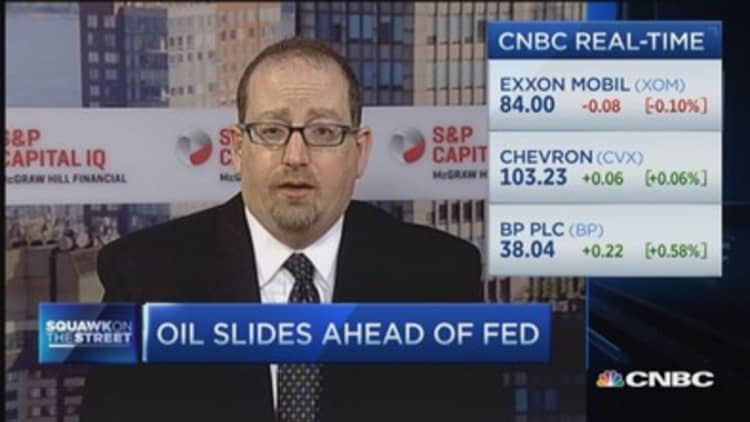
Oil futures have embarked on another leg downward as traders fret over the chance of increased supply from Iran and mounting U.S. crude stockpiles, but investors can rest easy in at least one regard, S&P Capital IQ's Stewart Glickman said on Wednesday.
"If there was one consistent theme coming from fourth-quarter earnings calls in February and January, it was the sanctity of the dividend. I really don't think that any of the major oils are going to be cutting their dividends, at least stateside," he told CNBC's "Squawk on the Street."
Last week, Italy's Eni became the first major oil company to cut its dividend and suspend share buybacks, amid a rout that has seen crude prices tumble about 60 percent from their highs in June.
To be sure, producers across the country will continue to face headwinds, Glickman said. Bentek Energy, a sister firm to S&P Capital IQ, projects West Texas Intermediate crude will average about $41 a barrel this year and $48 next year. The 2015 forecast presumes WTI will break below $40 at some point, Glickman added.
Read More Iran oil supply concerns are 'unduly bearish': Analyst
U.S. crude touched a session bottom of $42.05 on Wednesday, the lowest level since March 2009. Oil prices remain in contango, a state in which the current price of a commodity contract is cheaper than forward-looking futures prices.
Even Exxon Mobil—which Glickman called very well managed and the best in the business for generating return on capital—expects production growth through 2017 to be "pretty anemic," he noted.
"It's going to be a vehicle for buybacks and dividends, but we don't see a whole lot of upside," he said.
On Wednesday, the U.S. government's Energy Information Administration reported that inventories of commercial crude had surpassed record levels for a 10th straight week, reaching nearly 460 million barrels in storage.
Glickman said supply at the Cushing, Oklahoma, delivery point for the WTI contract had not reached crisis levels yet, but was significant enough to keep pressure on oil prices. The facility is currently at about 70 percent capacity, versus 25 percent a year ago, he noted.
Read More
Should stockpiles remain elevated, some exploration and production companies could shut in some wells. Upstream producers may also send more light crude to Canada, particularly condensate, which can be used to dilute heavy Canadian oil and improve flow through southbound pipelines.
"As long as we stay in contango, and as long as there's still additional storage capacity to fill, I think those numbers are going to continue to fill and I think it's going to be keep putting downward pressure," Glickman said.


